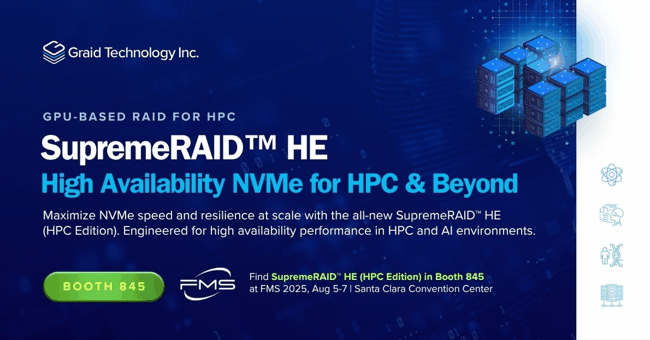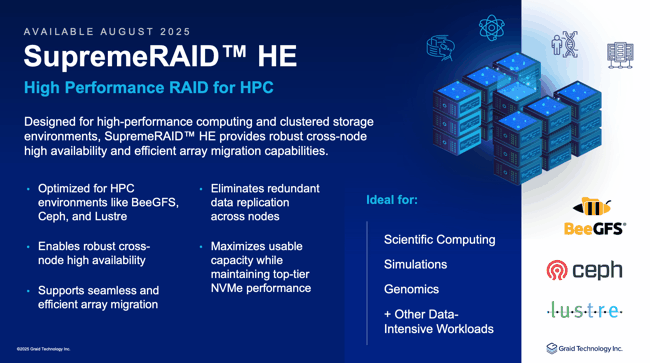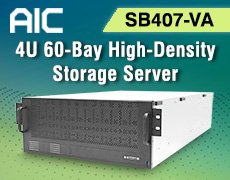FMS 2025: Graid Technology Introduces SupremeRAID HE for HA HPC and AI Workloads
Offloads RAID operations from CPU to GPU, unlocking extreme NVMe performance - up to 132GB/s read and 83GB/s write throughput after RAID processing
This is a Press Release edited by StorageNewsletter.com on August 5, 2025 at 2:02 pmGraid Technology, Inc. announces the availability of SupremeRAID HE (HPC Edition) – a new addition to the SupremeRAID product family engineered for HPC, AI factories, and enterprise environments that demand both speed and resilience at scale.
SupremeRAID HE is a first GPU-based RAID solution designed specifically for high availability in clustered and distributed environments. It offloads RAID operations from the CPU to the GPU, unlocking extreme NVMe performance – up to 132GB/s read and 83GB/s write throughput after RAID processing – while freeing up CPU resources for upper-layer applications.
Engineered specifically for HPC, AI factories, and enterprise workloads that demand both speed and resilience at scale, this GPU-accelerated high availability solution helps safeguard data, maintain regulatory standards, and keeps demanding applications running at scale — maximizing both resilience and speed.
Designed for Distributed, Performance-Hungry Environments
SupremeRAID HE achieves breakthrough performance in clustered and distributed systems by shifting RAID operations from the CPU to the GPU. By leveraging GPU acceleration, it unlocks exceptionally high NVMe throughput — up to 132GB/s for reads and 83GB/s for writes after RAID processing — freeing up CPU resources for critical application workloads and improving overall system efficiency.
Built for environments where high availability is critical, SupremeRAID HE features integrated array migration across nodes and cross-node RAID protection without the need for data replication. That means more usable capacity, lower TCO, and simplified failover…even in the most demanding enterprise and HPC infrastructures.
Supporting Ceph, Lustre, MinIO, IBM SpectrumScale, and More
Originally showcased in a joint reference architecture with Supermicro and BeeGFS, SupremeRAID HE is now fully hardware- and file-system agnostic. The latest release supports popular parallel file systems including Ceph, Lustre, MinIO, and IBM SpectrumScale, as well as deployment across JBOFs with Broadcom BF3 switches. This flexibility makes SupremeRAID HE ideal for organizations looking to maximize NVMe efficiency across diverse storage environments.
Unlock Full Potential of NVMe
Whether you’re scaling an AI cluster, building out an HPC node, or modernizing enterprise storage architecture, SupremeRAID HE empowers team to achieve:
- GPU-accelerated RAID performance with near-theoretical throughput
- Cross-node high availability without replication
- Increased CPU headroom for upper-layer services
- integration across a broad range of infrastructure
SupremeRAID HE Technical Specs:
SupremeRAID HE Linux Driver 1.7.2 Release Notes, Software, and Documentation
- Supports up to 32 drives
- Supports RAID-0/1/5/6/10
- Supports NVMe-oF
- Supports dual controllers
- Supports array migration
- Support for erasure coding coming soon
- Linux only
- OS: Compatible with Ubuntu versions 20-24.04 and RHEL versions 8.x-9.x
SupremeRAID HE is bundled as a GPU card + license: GPU options are NVIDIA RTX A1000 8GB or NVIDIA 2000 Ada 16GB, see physical specs below for more information.
NVIDIA RTX A1000 Workstation GPU (8GB)
- GPU Memory: 8GB GDDR6
- Display Ports: 4x mini DisplayPort 1.4a
- Max Power Consumption: 50 W
- Graphics Bus: PCIe Gen 4 x 8
- Form Factor: 2.7” (H) x 6.4” (L) single slot
- Thermal: Active
NVIDIA RTX 2000 Ada Generation GPU (16GB)
- GPU Memory: 16GB GDDR6 with error-correcting code (ECC)
- Display Ports: 4x mini DisplayPort 1.4a
- Max Power Consumption: 70 W
- Graphics Bus: PCIe Gen 4 x 8
- Form Factor: 2.7” (H) x 6.6” (L) dual slot
- Thermal: Active
- VR Ready: Yes
Resources:
Explore Joint HPC Solution with Supermicro
To learn how SupremeRAID HE performs in a 2U dual-node all-flash system with BeeGFS and Supermicro’s Petascale High Availability Dual Node All-Flash platform,
Full solution brief (PDF)
















 Subscribe to our free daily newsletter
Subscribe to our free daily newsletter


